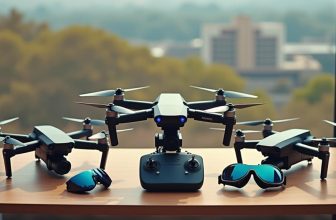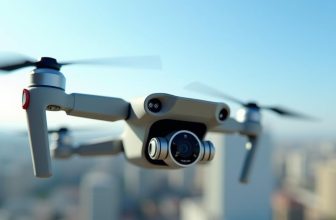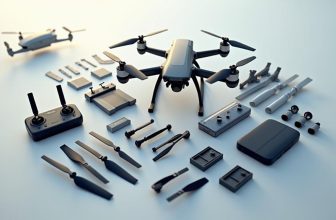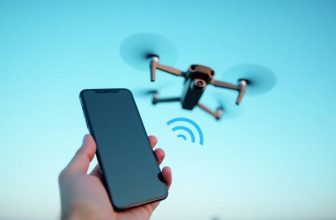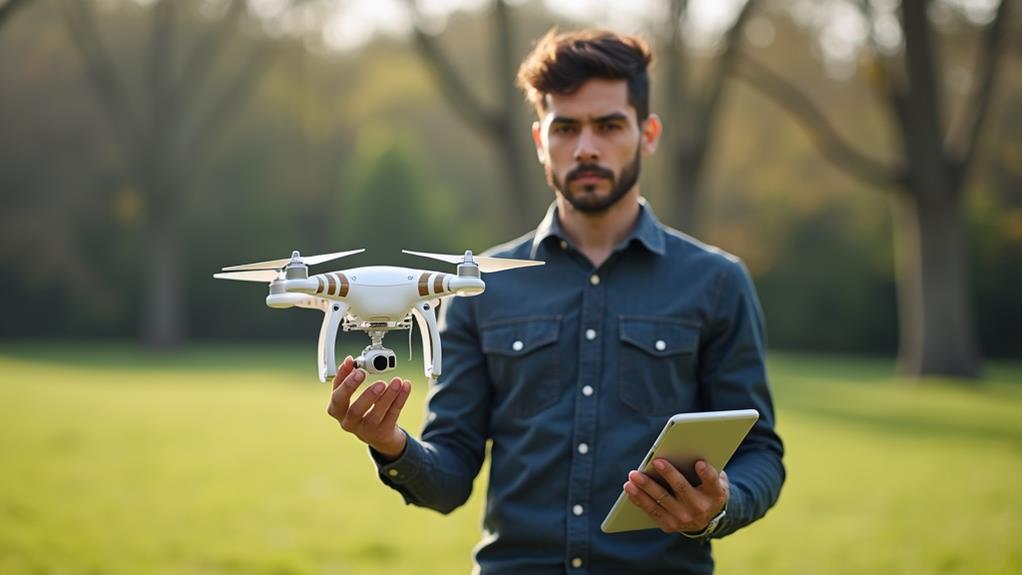
If you're considering taking to the skies with a quadcopter drone, you're not alone. As a beginner, you're probably eager to get started, but it's essential to approach this exciting hobby with a solid foundation. You'll need to master seven key steps to ensure a safe and enjoyable experience. From choosing the right drone to refining your flight skills, each step plays a crucial role in your development as a drone pilot. But before you can even think about taking off, you need to start with the basics – selecting a suitable drone that meets your needs. What factors should you consider when making this critical decision?
Contents
Key Takeaways
- Familiarize yourself with airspace regulations and No Fly Zones to ensure safe flying.
- Master pitch controls to maintain altitude and movement with smooth, gradual inputs.
- Practice yaw movement for smooth turns and navigating through tight spaces.
- Develop throttle precision for steady altitude and airspeed control.
- Understand takeoff and landing techniques for safe and controlled flying.
Choose the Right Drone
When selecting a quadcopter drone, consider what you'll be using it for – whether that's recreational flying, aerial photography, or racing.
This will help you determine your Drone Budget and what features you need. If you're a beginner, a lower-cost drone with a camera might be the best choice.
Recreational drones typically cost between $100 and $500.
However, if you're planning to use your drone for commercial purposes, like aerial photography or videography, you'll need a more advanced model that can cost upwards of $1,000.
Before you make a purchase, check if your drone requires Drone Registration with the Federal Aviation Administration (FAA).
In the US, drones weighing over 0.55 pounds and under 55 pounds must be registered.
Make sure you understand the regulations in your area to avoid any fines or penalties.
When choosing a drone, consider the features you need, like GPS, altitude hold, and a high-quality camera.
Also, think about the drone's size, weight, and durability.
Understand Basic Drone Components
Four key components make up a quadcopter drone: the frame, motors, propellers, and flight controller.
Understanding these components is crucial to grasping the drone's anatomy and ensuring proper maintenance.
The frame is the drone's body, providing structural support and housing other components.
Motors are responsible for propelling the drone, with each one attached to a propeller.
Propellers generate lift and thrust, allowing the drone to fly.
To better understand drone components, consider the following:
- Propeller maintenance: Regularly inspect propellers for damage or wear, replacing them as needed to maintain optimal performance and prevent accidents.
- Motor efficiency: Ensure motors are properly balanced and calibrated to optimize power consumption and flight time.
- Flight controller calibration: Familiarize yourself with the flight controller's settings and calibration procedures to fine-tune your drone's performance and stability.
Safety Precautions and Rules
Operating a quadcopter drone safely requires careful consideration of various precautions and rules.
You need to be aware of the airspace regulations in your area, which dictate the maximum altitude and distance you can fly your drone.
Familiarize yourself with local laws and regulations, as they may vary.
You should also be aware of No Fly Zones, which include areas around airports, military bases, and other sensitive infrastructure.
Flying in these areas can lead to serious consequences, including fines and confiscation of your drone.
You can use online tools or mobile apps to check for No Fly Zones in your area.
Additionally, you should always maintain visual line-of-sight with your drone and avoid flying over people or animals.
You should also be mindful of weather conditions, such as strong winds and thunderstorms, which can affect the stability and control of your drone.
Learn Basic Flight Controls
When flying a quadcopter drone, you'll need to understand the three primary flight controls: pitch, yaw, and throttle.
Mastering these controls will enable you to navigate your drone with precision and confidence, so it's essential to learn how they work together.
Understanding Pitch Controls
Mastering pitch controls is the next essential step in learning basic flight controls for a quadcopter drone.
Pitch controls allow you to tilt the drone forward or backward, which affects its altitude and movement.
To understand pitch controls, you must grasp the concept of axis rotations and angle adjustments.
When you adjust the pitch, you're essentially changing the drone's angle of attack.
This movement is achieved by rotating the drone's motors in a synchronized manner, creating a tilt in the desired direction.
Here are a few key things to keep in mind when working with pitch controls:
- Forward pitch: Tilting the drone forward will cause it to descend and move forward.
- Backward pitch: Tilting the drone backward will cause it to ascend and move backward.
- Neutral pitch: When the drone is in a neutral position, it will maintain its current altitude and remain stationary.
Remember to adjust your pitch controls smoothly and gradually to maintain control of the drone.
Sudden movements can cause the drone to become unstable and difficult to manage.
Practice makes perfect, so be sure to spend time getting familiar with your drone's pitch controls.
Mastering Yaw Movement
You're now familiar with roll and pitch controls, and it's time to learn the third essential component of basic flight controls: yaw movement.
Yaw movement refers to the rotation of your drone around its vertical axis. It's essential for smooth turns and navigating through tight spaces.
To master yaw movement, you'll need to learn how to make precise yaw adjustments.
Most drone controllers have a yaw stick, usually the left stick on most models. Moving the stick to the left or right will rotate your drone in the corresponding direction.
Start by making small yaw adjustments to get a feel for how your drone responds.
Practice making smooth turns by rotating your drone while maintaining a steady altitude and airspeed.
Focus on making gradual, gentle turns to avoid overcorrecting.
As you get more comfortable with yaw movement, you can start to make more precise adjustments and navigate through tighter spaces.
Using Throttle Effectively
Using Throttle Effectively
Effective throttle control is one of the most critical aspects of flying a quadcopter drone, and it's essential to get it right from the start.
The throttle controls the drone's altitude, and mastering it takes practice and patience.
To use the throttle effectively, you'll need to calibrate it first. Throttle calibration ensures that your drone responds accurately to your inputs.
Once calibrated, focus on developing throttle precision. This means making smooth, gradual adjustments to maintain a steady altitude.
Here are some key points to keep in mind when using the throttle effectively:
- Understand the throttle curve: The throttle curve determines how the drone responds to your inputs. A linear throttle curve provides a more direct response, while an exponential curve offers more control at lower speeds.
- Practice smooth throttle adjustments: Avoid sudden, abrupt changes in throttle, as they can cause the drone to wobble or lose stability. Instead, make smooth, gradual adjustments.
- Monitor your drone's altitude: Keep a close eye on your drone's altitude and adjust the throttle accordingly. This will help you maintain a steady height and prevent crashes.
Mastering Takeoff and Landing
As you prepare for lift-off, keep in mind that takeoff and landing are the most critical phases of flying a quadcopter drone.
To master takeoff, start by ensuring your drone's propellers are at a safe distance from obstacles. Then, slowly increase the throttle until your drone lifts off the ground.
Keep the drone stable and level by adjusting the roll, pitch, and yaw controls.
When it's time to land, slowly decrease the throttle and begin your descent.
It's essential to maintain a steady and controlled pace to achieve smooth landings. Aim for a gentle touchdown by keeping the drone level and stable.
As you approach the ground, reduce the throttle even further to minimize the impact. Avoid sudden movements, as they can cause the drone to wobble or lose control.
Practice makes perfect, so don't be discouraged if you don't get it right immediately.
With time and patience, you'll develop the skills necessary to master takeoff and landing. Remember to stay focused and keep your drone under control to ensure safe and successful flights.
Mastering takeoff and landing skills lays the groundwork for navigating complex environments.
As you progress, you'll encounter obstacles that require more advanced techniques to overcome. Navigating obstacles and space demands a combination of spatial awareness and control of your quadcopter.
When flying in open areas, consider the following factors to enhance your navigation skills:
- Understand wind resistance: Be aware of wind direction and speed, as it can significantly impact your drone's stability and movement.
- Develop spatial awareness: Visualize the environment and anticipate potential hazards, such as trees, buildings, or power lines.
- Use visual references: Identify landmarks or features in your surroundings to help guide your drone and maintain orientation.
As you navigate through complex environments, keep in mind that small adjustments can make a significant difference in maintaining control.
Keep your eyes on the drone and the surrounding area, and be prepared to make quick adjustments to avoid obstacles.
Practicing and Refining Skills
You've mastered navigating obstacles and space, now it's time to focus on practicing and refining your skills.
Mastering basic maneuvers such as hovering, yawing, and banking is crucial before building advanced techniques.
Mastering Basic Maneuvers
Basic maneuvers are the building blocks of quadcopter drone flight, and they require practice to refine.
Mastering these skills is crucial for smooth transitions and controlled flight. As you practice, focus on making angular movements with precision and accuracy.
To improve your basic maneuvers, try the following techniques:
- Forward and backward flight: Practice flying in a straight line, focusing on maintaining a steady altitude and speed.
- Lateral movement: Move your drone from side to side, using gentle and smooth inputs on the remote controller.
- Yaw control: Rotate your drone clockwise and counterclockwise, keeping it steady and controlled.
As you master these basic maneuvers, you'll notice significant improvements in your flying skills.
Your transitions will become smoother, and your angular movements more precise.
With consistent practice, you'll develop muscle memory and be able to execute these maneuvers with ease.
This foundation will serve as a stepping stone for more advanced techniques and complex flight maneuvers.
Building Advanced Techniques
Now that you've refined your basic maneuvers, it's time to build upon those skills and develop advanced techniques.
You'll be able to execute more complex aerial maneuvers and expand your flying capabilities. Start by practicing flips and rolls in a controlled environment, gradually increasing your speed and altitude.
This will help you develop muscle memory and better coordination.
Aerial Acrobatics involves flying your drone in a more dynamic and aggressive manner, incorporating advanced maneuvers such as flips, rolls, and dives.
Mastering these techniques requires patience, focus, and a thorough understanding of your drone's capabilities. Advanced Aerobatics involves combining multiple maneuvers in a single flight, creating a seamless flow of movement.
To refine your skills, practice regularly and analyze your flights to identify areas for improvement.
Focus on smooth transitions between maneuvers and maintain control throughout the flight.
As you progress, you'll be able to execute complex aerial sequences with precision and confidence, pushing your flying skills to the next level.
Frequently Asked Questions
Can I Fly a Drone in Heavy Rain or Snow?
You shouldn't fly a drone in heavy rain or snow as these harsh weather conditions can damage the drone's electronics, reducing its durability and potentially causing it to malfunction or crash.
Do I Need Drone Insurance for Recreational Use?
When flying a drone recreationally, you're assuming drone liability risk, which may put your personal assets at stake in case of accidents or property damage. You don't necessarily need insurance, but it's highly recommended.
Can I Modify My Drone's Propellers for Better Performance?
You can modify your drone's propellers for better performance by choosing from various Propeller Materials like carbon fiber or nylon, and Custom Designs that suit your drone's specifications and flying style, but ensure compatibility and safety.
How High Can I Legally Fly My Quadcopter Drone?
"Absolute power corrupts absolutely," so don't abuse your drone's capabilities. You're generally allowed to fly up to 400 feet above ground level, following airspace regulations and respecting altitude limits to avoid violating FAA rules.
Can I Fly a Drone While Wearing Prescription Glasses?
You can fly a drone while wearing prescription glasses, as most modern drones don't restrict glasses compatibility. However, consider your vision limitations, ensuring your glasses don't obstruct your view or interfere with drone controls.
Conclusion
As you master the seven essential steps, imagine the rush of your quadcopter soaring into the sky, its propellers whirring in sync. Coincidentally, the trees sway in the wind, their leaves rustling like the soft hum of your drone. With each flight, your skills refine, and your drone becomes an extension of you. Analyze, practice, and repeat – the more you fly, the more seamless your connection becomes, until the drone is just a natural part of your aerial journey.



